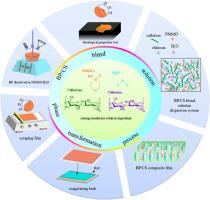Industrial Crops and Products ( IF 5.9 ) Pub Date : 2021-06-21 , DOI: 10.1016/j.indcrop.2021.113747 Hongmei Yuan , Jianfei Wu , Dong Wang , Liulian Huang , Lihui Chen , Shan Lin

|
Regenerated cellulose (RC) films have numerous separation and purification applications. However, the mechanical properties of RC films are poor. Because of their very similar chemical structures and excellent compatibility, chitosan (CS) particles were chosen to reinforce bamboo-derived dissolving pulp (BP)-based films. BP/CS blend solutions were obtained by mixing BP and CS particles at different weight percentages into N-methyl-morpholine-N-oxide (NMMO) solvent. The BP/CS composite films prepared by the traditional phase transformation method formed a physically cross-linked network with high packing density for the water evaporation after air-drying. Due to the strong hydrogen bonding between CS and BP revealed by rheological properties and Fourier transform infrared (FTIR) data, the CS particles dispersed uniformly in the matrix, and the compatibility of the reinforcement with the matrix was excellent, which was further confirmed by X-ray diffraction (XRD), scanning electron microscopy (SEM) and UV–vis transmittance data. As the weight percentage of CS increased from 9.09 wt% to 14.24 wt%, the crystallinity of cellulose II increased from 32.20%–38.59%, and the tensile strength of the BP/CS composite films increased from 662.20 MPa to 865.53 MPa, respectively. These results indicate that the tensile strength of the BP/CS composite films was increased by nearly 250.83 %–358.56 % compared with that of the regenerated BP film (188.75 MPa). Moreover, the elongation at break was increased by 51.16 %-41.63 %. These findings provide a new way to prepare ultra-high-strength RC composite films.
中文翻译:

竹源溶解浆和壳聚糖的NMMO溶液制备超高强度复合薄膜
再生纤维素 (RC) 薄膜具有多种分离和纯化应用。然而,RC薄膜的机械性能较差。由于它们非常相似的化学结构和优异的相容性,壳聚糖 (CS) 颗粒被选择来增强竹衍生的溶解浆 (BP) 基薄膜。通过将不同重量百分比的 BP 和 CS 颗粒混合到 N-甲基-吗啉-N-氧化物 (NMMO) 溶剂中,获得 BP/CS 共混溶液。传统相变方法制备的BP/CS复合薄膜在风干后形成了具有高堆积密度的物理交联网络,用于水分蒸发。由于流变学特性和傅里叶变换红外 (FTIR) 数据揭示了 CS 和 BP 之间的强氢键,CS 颗粒均匀地分散在基体中,X 射线衍射 (XRD)、扫描电子显微镜 (SEM) 和紫外-可见光透射数据进一步证实了增强材料与基体的相容性。随着 CS 的重量百分比从 9.09 wt% 增加到 14.24 wt%,纤维素 II 的结晶度从 32.20% 增加到 38.59%,BP/CS 复合膜的拉伸强度分别从 662.20 MPa 增加到 865.53 MPa。这些结果表明,与再生 BP 膜 (188.75 MPa) 相比,BP/CS 复合膜的拉伸强度提高了近 250.83%–358.56%。此外,断裂伸长率增加了 51.16 %-41.63 %。这些发现为制备超高强度RC复合薄膜提供了一种新方法。X 射线衍射 (XRD)、扫描电子显微镜 (SEM) 和紫外-可见光透射数据进一步证实了这一点。随着 CS 的重量百分比从 9.09 wt% 增加到 14.24 wt%,纤维素 II 的结晶度从 32.20% 增加到 38.59%,BP/CS 复合膜的拉伸强度分别从 662.20 MPa 增加到 865.53 MPa。这些结果表明,与再生 BP 膜 (188.75 MPa) 相比,BP/CS 复合膜的拉伸强度提高了近 250.83%–358.56%。此外,断裂伸长率增加了 51.16 %-41.63 %。这些发现为制备超高强度RC复合薄膜提供了一种新方法。X 射线衍射 (XRD)、扫描电子显微镜 (SEM) 和紫外-可见光透射数据进一步证实了这一点。随着 CS 的重量百分比从 9.09 wt% 增加到 14.24 wt%,纤维素 II 的结晶度从 32.20% 增加到 38.59%,BP/CS 复合膜的拉伸强度分别从 662.20 MPa 增加到 865.53 MPa。这些结果表明,与再生 BP 膜 (188.75 MPa) 相比,BP/CS 复合膜的拉伸强度提高了近 250.83%–358.56%。此外,断裂伸长率增加了 51.16 %-41.63 %。这些发现为制备超高强度RC复合薄膜提供了一种新方法。纤维素II的结晶度从32.20%~38.59%提高,BP/CS复合薄膜的拉伸强度分别从662.20 MPa提高到865.53 MPa。这些结果表明,与再生 BP 膜 (188.75 MPa) 相比,BP/CS 复合膜的拉伸强度提高了近 250.83%–358.56%。此外,断裂伸长率增加了 51.16 %-41.63 %。这些发现为制备超高强度RC复合薄膜提供了一种新方法。纤维素II的结晶度从32.20%~38.59%提高,BP/CS复合薄膜的拉伸强度分别从662.20 MPa提高到865.53 MPa。这些结果表明,与再生 BP 膜 (188.75 MPa) 相比,BP/CS 复合膜的拉伸强度提高了近 250.83%–358.56%。此外,断裂伸长率增加了 51.16 %-41.63 %。这些发现为制备超高强度RC复合薄膜提供了一种新方法。此外,断裂伸长率增加了 51.16 %-41.63 %。这些发现为制备超高强度RC复合薄膜提供了一种新方法。此外,断裂伸长率增加了 51.16 %-41.63 %。这些发现为制备超高强度RC复合薄膜提供了一种新方法。



























 京公网安备 11010802027423号
京公网安备 11010802027423号